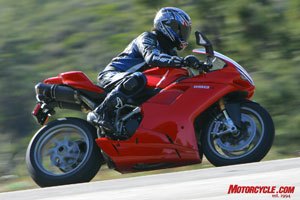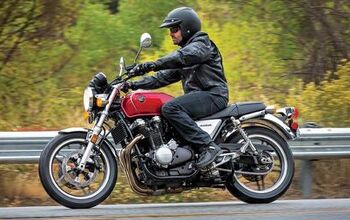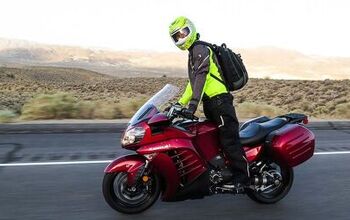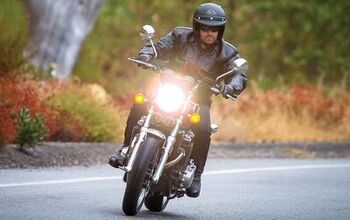Choose a Motorcycle That Fits
A motorcycle that fits well is more comfortable to operate, easier to control, safer to use, and ultimately more enjoyable to ride.
It should fit in a few senses of the word. A motorcycle should fit the rider’s body, so hands, feet and backside are comfortably positioned, with all switches and levers easily operable. Likewise, it should fit the rider’s intended purpose and experience level.
Motorcycle manufacturers have evolved several styles. These include sportbikes, touring bikes, sport tourers, cruisers, standards, and dual purpose.
| Allstate Insurance On Rider Safety |
Our friends at Allstate Motorcycle Insurance know a thing or two about motorcycle safety. In addition to Motorcycle.com's safety series, Allstate Motorcycle Insurance has its own valuable safety information to share. * Motorcycle Awareness: Safety Tips from Allstate Motorcycle Insurance |
For some designs, it could seem that the old axiom of “form follows function” may or may not be perfectly conformed to, but then this might be more a question of what “function” do you have in mind?
Perfect fit for a sportbike might not work as well for a cruiser rider who wants to relax and take in the scenery, or a tourer who wants to do hundreds of miles a day. Having a good idea of how you expect to use the motorcycle will determine your best compromise, which ultimately is what defines a good riding position.
Acknowledging also whether you have any physical limitations is important. If you have issues with your back, wrists, excess weight, or otherwise; or if you are very short or tall, these will have to be considered.
As it is, many riders try to conform themselves to their bikes. And while this works in a lot of cases, some may not realize they are tolerating issues they might not have to, and how they fit affects how well they wind up liking a bike.
Also to be seriously considered: just because you may be able to ride a motorcycle does not necessarily mean it is a good choice. Too high a power-to-weight ratio for your experience level means you’ll be able to accelerate too easily when trying to learn handling and braking.
But assuming you have at least a fair idea of a bike you’d like to get, there are several ergonomic factors you can size up in order to determine whether you and a motorcycle may be poised for a good long-term relationship.
While you may not want to go so far as to re-engineer a bike on the showroom floor, it is good to know that a few simple changes might be possible. Following are basic criteria to consider, and a few pointers for making an off-the-rack fit more like custom tailoring either when buying a bike, or after you have lived with it for a while.
Hands
Switches should be within easy reach of fingertips. In some cases, you may be able to loosen the hardware to switch housings and rotate them, or push them away or pull them closer so knobs and buttons are more accessible.
The same applies to your front brake and clutch levers. Are they angled so your fingers naturally reach? They may be able to be rotated to a better position. Also, are they close enough to cover with a couple fingers? If they are adjustable, set them within easy reach. If you can’t get them right, aftermarket companies may have options for you.
And as for the handlebars themselves, if they are uncomfortable, it may mean the bike is not right for you unless you want to spend time and money to swap them. But in some cases you may not know until after you already own a bike, and have ridden some miles, whether you’d be more comfortable with a higher, lower, wider or narrower bar (or clip-on handlebars as the case may be).
If you think different handlebars might be what you want however, a look through an aftermarket catalog will reveal lots of options. A small change in height or width may be possible without having to re-do cables or wires. A wider bar can be cut down on each side for a narrower grip, but all things being equal, it will also mean a shorter push will now initiate a given steering change, while also requiring greater effort. Conversely, installing a wider bar will mean a longer push will be needed to initiate a given steering change, while requiring less effort. Installing a higher bar may relieve your back and/or wrists (and give you more leverage similar to a wider bar at the same time). Keep in mind, the more upright you are, the more the wind affects you, unless you have a windscreen and it’s high enough. And as a word of caution: since changing your bars alters the bike’s steering quickness, control, center of gravity and aerodynamic considerations to one degree or another, be sure to discuss any proposed modifications with a dealer or someone equally qualified.
Feet
The rear brake should be easy to cover, and the shifter should be operable without having to lift or slide your foot off the peg, or extend your toes up or down uncomfortably far.
As for the positioning of the footpegs, this is another issue you may not know you’ll want to adjust until after you have put miles on a bike, and are already committed to it.
Fortunately footpeg position is often adjustable. For example, aftermarket companies offer rearset kits for sportbikes or forward set peg kits for many cruisers. New shifter and brake linkage is usually part of the conversion.
Keep in mind the more forward your feet, the more your weight will be supported by your backside. The more rearward your feet, the more your fanny may be comfortable, but you may bend your legs more.
Saddle
The saddle affects how well your feet reach the ground, and how you are positioned relative to the handlebar and footpegs. Its height should allow you to touch both feet to the floor. Some riders learn to make due touching only one foot at a time, but this is less than optimal and should be avoided if possible. If you are close, a lower custom saddle could make the difference.
In addition to lowering or raising you, a custom saddle might also naturally place you more fore or aft to a degree, which may or may not be desirable.
Summary
Choosing a new bike can be a best guess. Many people are fine with a manufacturer’s standard configuration, but it’s possible you could find yourself hurting in places, or feeling awkward and unable to get used to a bike as well as you had hoped.
The three points of contact – hands, feet, and saddle – all interrelate, and there are possible adjustments for each, as needed or desired.
Several potential changes are bolt on, or adjustment-level, and do not involve major surgery. And then, other modifications do take more work and planning, and you’ll have to decide if they’d be worth it. Understand also, that you may affect center of gravity and handling dynamics if you go so far as to change your position on the bike with a higher or lower handlebar, custom saddle or offset footpegs.
Always take care what you contemplate, and consult with qualified help as necessary. And lastly, if you do change anything, make sure all controls – especially things like brake levers – work properly, and won’t bind under any conditions. You don’t want to inadvertently compromise safety while thinking you have made an ergonomic improvement.
Knowing your options in advance can help you avoid choosing a completely wrong motorcycle, while giving you assurance that if you are close and would like to optimize the fit, you may be able to do more than you might have known.
Related Reading
How Well Do You Know Your Motorcycle?
Rider Education, Injuries and Fatalities
What to Wear When You Ride - and Why
The SEE System: Increasing Your Visibility
Motorcycle Insurance Basics
The American Culture of Motorcycle Safety
Group Riding 101
Should You Ride a Motorcycle
How to Load Your Motorcycle
Night Riding
Riding With a Passenger
Riding in the Rain and Wind
The Truth about Drinking and Riding
Road Conditions Quiz
Knowing How to Brake Saves (the most) Lives
More by Jeff Cobb































Comments
Join the conversation